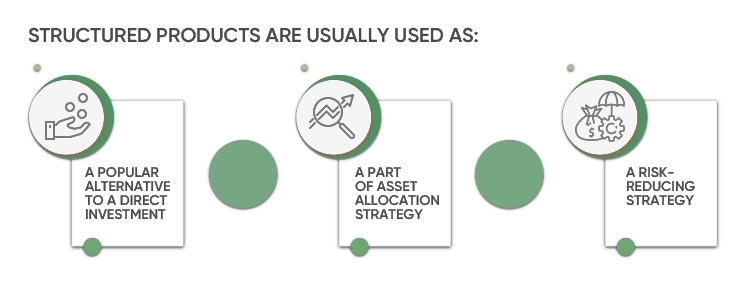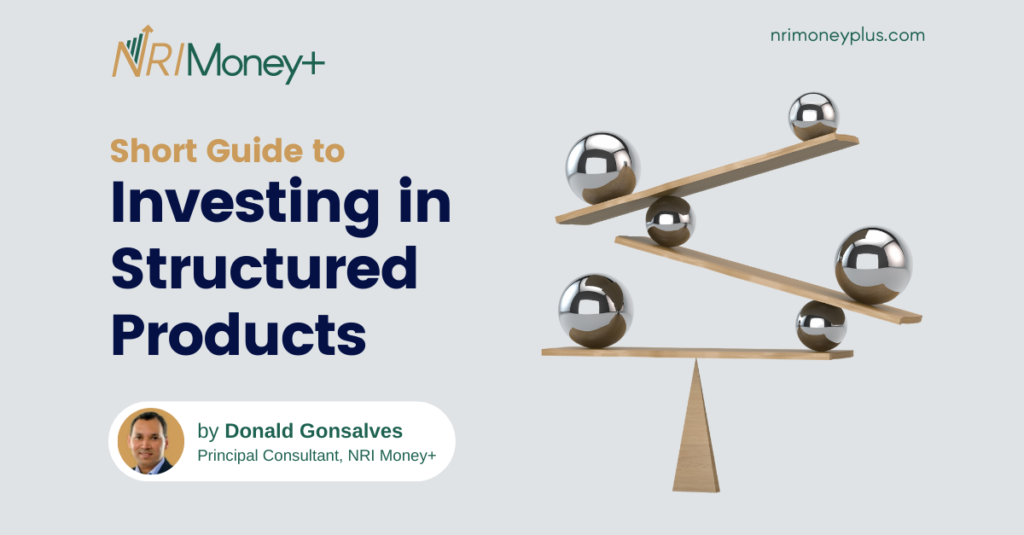In recent years, structured products have exploded in popularity across the globe, particularly in India. Since they are securities traded on SEC exchanges, individual investors have the same level of access to them as they do to bonds, equities, and ETFs (ETFs).
Structured products have proven to be a valuable addition to conventionally diversified portfolios by providing investors with individualised access to previously inaccessible asset classes.
What are Structured Products?
Structured products, also referred to as market-linked investments, are pre-packaged financial instruments that are based on the performance of a single security, a basket of securities, an index, a commodity, an option, a debt issue, or a foreign currency. Banks issue structured products, which include a range of periods, rewards, and risk profiles.
Many structured products are hybrid securities, much like other widely used market instruments. They often come in two pieces: a note and a derivative. You might receive interest from the note at the set rate and frequency. The issuer has the option to sell or buy the referred securities from you at a predetermined price because the derivative element of the contract affects payment at maturity.
Structured products are described as “securities whose cash flow characteristics depend upon one or more indices or that have embedded forwards or options or securities where an investor’s investment return and the issuer’s payment obligations are contingent on, or highly sensitive to changes in the value of underlying assets, indices, interest rates, or cash flows” by the US Securities and Exchange Commission (SEC).
The majority of structured products assume a set maturity and may pay you a coupon rate or interest rate. Typically, they are developed to address unique requirements that cannot be satisfied by using widely available traditional financial instruments.

How Structured Products Work?
Consider the case when a reputable and well-known bank produces structured notes with a $1,000 face value. A zero-coupon bond and a call option on the underlying asset are the two parts of each package that each note represents (a common stock or an ETF, following the popular market index). The note has a three-year maturity.
The fundamental idea behind this instrument is rather straightforward. You must pay the $1,000 face amount on the issuing date. No matter what happens to the underlying asset, you are completely covered by this note and will receive a return of your investment at maturity.
When it comes to the performance component, the underlying asset is valued as a European call option and will have intrinsic value if its value at maturity is higher than its value at the time of issuance. If applicable, you will receive that return; otherwise, nothing above your $1,000 will be given to you.
A full principal protection is one of the main advantages of investing in structured products, but an investor may choose to forego all or part of the protection in favour of more alluring performance protection.
Pros of Structured Products
Here are some key features and advantages for people considering adding structured products to their investment portfolio:
- Possibility of higher returns after adjusting for risk. Structured products, which combine characteristics of multiple asset classes into a single investment, may be a useful addition to a well-diversified portfolio. For instance, if we take an index-linked note, it will behave more like a debt instrument if its value declines and like an underlying index if it increases. Structured products give investors the chance to increase returns by potentially lowering the volatility of the entire portfolio.
- Individualised risk/return profiles. Structured products offer the opportunity to modify the risk/return characteristics of the underlying investments in order to either maximise projected performance or mitigate risks associated with certain securities, including commodities, currencies, and other investments. While many principal-protected products are created to insulate against the danger of loss, many enhanced growth and enhanced yield structured products are built to outperform the underlying asset.
- Access to investments that were previously out of reach. Due to their high cost or general complexity, many structured products give individual investors access to a variety of markets that were previously inaccessible through ordinary investments. Structured products are thought of as economical tools.
- Restricted maximum loss potential. The fact that the maximum potential loss is constrained to the initial investment is one of the most alluring characteristics of structured products. Margin is not a requirement for structured products.
Cons of Structured Products
You should examine the dangers of structured products in addition to their main advantages when deciding whether to incorporate them in your investment portfolio. The following is a list of some of the biggest risks associated with structured products:
- Possible loss of the principal. At maturity, some structured products protect the principal. The investor can only get their money back in full if they keep onto the structured product until its maturity date. Structured goods, however, are regarded as medium-term investments (1–10 years), and as such, the price may change significantly throughout this time. If the investor sells this investment before it reaches maturity, the price can be less than what was first invested.
- Market fluctuations. The price of the underlying asset, dividend rates, interest rates, time till maturity, and geopolitical situation are only a few of the myriad, sometimes unforeseen aspects that affect structured products’ value.
- Risk of credit. A few structured products are sold as unsecured debt. They become dependent on the credit and default risks of the issuer as a result.
- Complex. The returns from structured products are difficult to estimate. It implies that it is more challenging to assess and forecast the performance of structured products than it is for those who only own the underlying asset.
- Absence of liquidity Structured products may be traded over the counter as well as on stock exchanges. There is no assurance of a liquid trading market for a certain structured product, even if traded on a traditional exchange.
Investing in Structured Products
Structured products trading can be performed through NRI Money Plus with Edelweiss as our execution partner. Connect with us by simply sending a WhatsApp message to +91-9930607322 for email hello at nrimoneyplus dot com with your details.

Donald G. is the Principal Consultant at NRI Money+. He specialises in creating personalised financial plans for NRIs (Non-Resident Indians) and HNI (High Net-worth Individuals).



